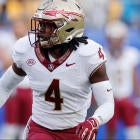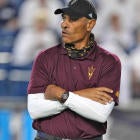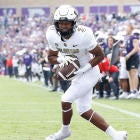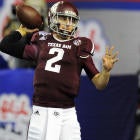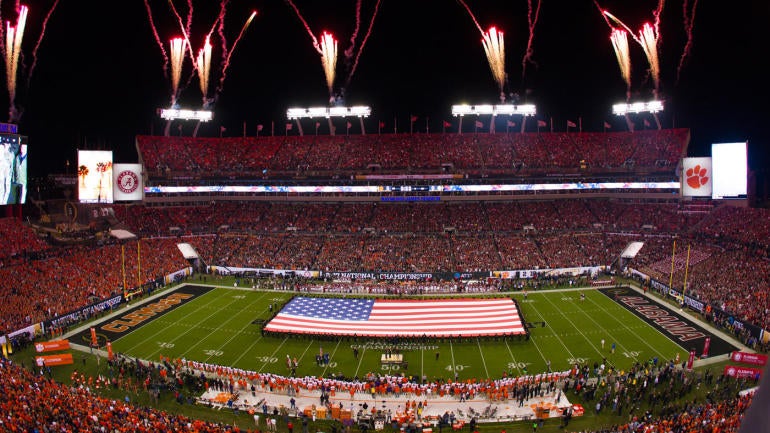
Might as well call it The Asterisk Season. Whatever happens as we enter the first week of Power Five football, there will be some sort of qualifier attached to it.
Whatever happens, however it plays out, this season won't be status quo. We live in a world where a heart condition (myocarditis) has made anybody who has taken an aspirin a medical expert.
College football in 2020 is at a crossroads of delight and detour. Delight because -- as long as it lasts -- the season is finally here. Detour because -- at any moment -- the game could be headed for a stoppage … or worse.
We go into the season not knowing at this late date what bowl eligibility even means. Such a term may be temporarily obsolete, Football Bowl Association executive director Nick Carparelli recently suggested after meeting with the NCAA.
Why wouldn't it be? CBS Sports bowls expert Jerry Palm currently has four winless teams in bowl games if all slots are filled. Never mind whatever a College Football Playoff will look like.
"Whoever wins this this year is going to be the greatest champion of all-time," Clemson coach Dabo Swinney said.
What's breaking news today can be worthless in a week. Or a day. It turns out the Pac-12 has been in a partnership with Quidel on rapid COVID-19 testing for quite a while. That will at least make it safer to be a Pac-12 athlete and may hasten an earlier return to football. But where was the Big Ten on such a partnership?
Big 12 commissioner Bob Bowlsby called wading into the season "a somewhat foggy future for all of us."
There will be a "right" and a "wrong" … maybe … someday. Just not now. It's too early.
We have to respect the decisions of those 54 FBS programs who have opted out of the fall season. It's too early to claim the Big Ten and Pac-12 decided too early (Aug. 11) on postponement. No one really knows.
Same for the ACC, Big 12 and SEC. They're playing in the fall but not on time and maybe not at the end if health conditions dictate.
"Ultimately, the virus is going to decide," said Brian Hainline, the NCAA's chief medical officer.
This is another way of saying, "Calm the heck down." Let's hope this is a one-season blip on the radar. Anything more could be devastating.
Financially, this was already going to be a slog. The NCAA is furloughing every one of its employees (except management). Alabama is reducing its budget 22%. Programs across the nation asked coaches to take temporary pay decreases. With cuts and furloughs, the Pac-12 has basically deemphasized its much-derided network.
For the first time this year, a college football Saturday will look somewhat recognizable with the ACC and Big 12 saddling up.
"This is our sport. This is our time," Kansas coach Les Miles said.
The Asterisk Season continues, though to what eventual end depends on who is speaking.
Will there be parity?
With such a fragmented season, the most obvious football question is whether some team (or two) will crack the College Football Playoff's cement ceiling.
That's the barrier that has kept all but 11 teams from playing for the national championship in the six-year history of the CFP. Predictably, three of those 11 teams – accounting for seven of the 24 combined spots -- are from the SEC.
Alabama has played in the five of the six CFPs, finally missing last season. After missing in Year 1, Clemson has played in five of the last six, winning two.
Is parity dead? We won't know for sure until later, but COVID-19 has made that question possible.
The SEC will be playing an unprecedented 10 conference games, bolstering even further their schedule strength. Will it drive the SEC's contenders or cannibalize them? What does an 8-3 SEC champion mean if, say, Cincinnati goes 11-0? We may be about to find out.
The CFP Selection Committee's protocols will have to change. Whether they tell us or not is another issue.
This insidious coronavirus has rendered the age-old practice of a game-by-game breakdown of the schedule. Do that at your own risk these days.
A 6-0 team might make the playoff. A 9-2 team might not. Until the CFP tells us it isn't possible, well, it is.
Social justice and player empowerment
Last Saturday, Stephen F. Austin players kneeled and raised fists before a kickoff during their game with UTEP. The first sideline image when their game hit the air was the Eastern Kentucky coaching staff wearing "Say Their Names" shirts on the sideline.
Clemson star quarterback Trevor Lawrence has been a leader in this area. On Sunday, he tweeted that players on game days "will use our platform to raise awareness," wearing shirts, displaying statements on helmets and playing videos to salute those impact by social injustice.
All of it is going to be an enduring, if not permanent, part of college football. Player empowerment is here to stay.
"What the future looks like, I think you're looking at it," Texas coach Tom Herman said. "I'm happy for our players to finally feel the freedom to speak what's on their mind and to speak what's on their heart."
Will there be two-semester football?
It's a whole new season with 76 teams playing in the fall and 54 others at least planning to give it a go in spring 2021.
With leagues playing mostly within themselves, it will be harder than ever to compare records. The arguments will be more shrill. As long as we can play football, won't that be wonderful?
As it stands, we can say with some confidence the national champion will come from the ACC, Big 12 or SEC. That is, the fall champion will be the CFP champion. The Heisman Trophy hasn't made up its mind yet. This is what a fall-only Heisman top five looks like.
- Chuba Hubbard, RB, Oklahoma State: Only one other Cowboy has run for more yards than Hubbard's 2,094 last season. That would be Barry Sanders.
- Trevor Lawrence, QB, Clemson: Motivated by the worst game of his career against LSU in the CFP National Championship, Lawrence enters as the favorite.
- Jaylen Waddle, WR, Alabama: This season's Swiss Army Knife is and NFL-quality receiver who can return kicks and punts.
- Derek Stingley Jr., CB, LSU: Cover corners are about as rare as rational Twitter discussion. LSU's freshman All-American may be the best defender in the country.
- Spencer Rattler, QB, Oklahoma: The Sooners' redshirt freshman has thrown seven career passes. Who cares? Las Vegas has fallen in love with him as a Heisman candidate. He already has the best quarterback coach as his head coach (Lincoln Riley).
What about the rankings?
Every major service, notably the AP Top 25 and Coaches' Poll, will include one-third of the participating teams. While that fact will contribute some coaches' bonus clauses at season's end, it allows some well-deserved attention for teams that usually would be left out.
The CBS Sports 130 76, the amended version of our regular weekly ranking of every FBS team, has already taken the reduced allotment of active programs into consideration. That allowed Tennessee, Iowa State, Virginia Tech, Louisville, Miami (FL), Kentucky, Florida State, Baylor, Pittsburgh and Appalachian State to enter the preseason top 25 where they otherwise would have been on the cusp.
Will there be frequent game cancellations?
Well, there will certainly be some because there has already been three. TCU-SMU, Baylor-Louisiana Tech and Oklahoma State-Tulsa have already been postponed after outbreaks of COVID-19 positives.
Whether games should be played or not based on available players actually has not yet been fully determined entering Week 2 of the season.
Only the Big 12 has such parameters. Last Friday, it announced the minimum number of players required for a game is 53. That total includes at least seven offensive linemen, four defensive linemen and one quarterback. Teams falling below any of those numbers could still elect to play. Otherwise, the game would be declared a "no contest" if it cannot be made up. Expect some form of that format to be adopted by other conferences.
That's why leagues have plugged in multiple bye weeks in their reconstituted schedules -- to create opportunities to make up games. It's also why the commissioners have insisted since early March that not everyone is going to end up playing a full schedule.
There is no way predict what's next with COVID-19. We've been told to prepare for a second wave in the fall/winter. Football must adjust accordingly. That means few hard and fast rules for players missing practice during game week.
"This year, you can throw that out the window," said Kansas State coach Chris Klieman said. "If a young man can practice a day or two and get in all the meetings, it's all hands on deck."
What if opt outs continue into the season?
This might be COVID-19's biggest lasting impact on the season. Some of the game's best and brightest stars have already chosen not to play. The CBS Sports opt out tracker has 83 Power Five players -- including many in the Big Ten and Pac-12 -- having decided not to play this season.
UCF (10) and LSU (four) have been particularly hard hit. The Tigers lost All-American receiver Ja'Marr Chase, adding to their already distressing loss of talent to the NFL and graduation.
Whether this is one-off amid COVID-19 or a trend for the future is yet to be known.
What's the status of COVID-19 testing?
It is getting better every day. The ACC, Big 12 and SEC are on board testing three times during game weeks with the third rapid test coming within 24 hours before kickoff. Duke has announced it will test its players daily.
The Pac-12 last Friday announced a "groundbreaking" a partnership with Quidel that will allow the conference to conduct daily on-site tests with rapid results.
All of it will help determine who is healthy enough to play. But until we get rid of the coronavirus in the form of a vaccine or therapeutic, we're still wandering and wondering.














